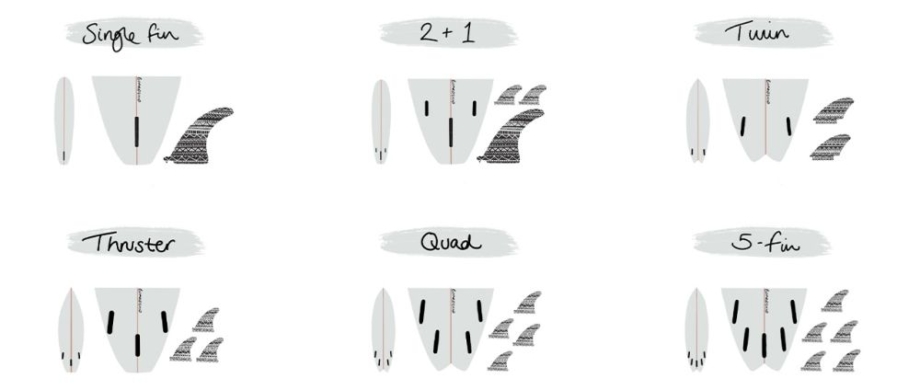
¿Qué hacen las aletas en una tabla de surf? Seleccionar el adecuado Configuración de las aletas de la tabla de surf es fundamental para obtener el máximo rendimiento y disfrute de su tabla. La cantidad de quillas, su tamaño, forma y ubicación influyen en el rendimiento de la tabla de surf. Comprender el tipos de aletas de tabla de surf Puede desbloquear nuevos niveles divertidos independientemente de sus niveles. Descubra los diversos configuraciones de aletas de tabla de surf de uso común, incluidas las configuraciones de aleta simple, aleta doble, propulsor, aleta 2+1 y cuádruple.
Esta guía explicativa de las aletas de las tablas de surf incluye las diferencias clave entre las tablas de surf con aletas, lo que le permite personalizar su tabla para las olas que desea surfear.
1. Configuración de una sola aleta
El mundo de configuraciones de aletas de tabla de surf La tabla de surf con una sola quilla se presenta en varias configuraciones, cada una de ellas adaptada a estilos de surf específicos y condiciones de olas. Sin embargo, la configuración con una sola quilla es un clásico atemporal que ofrece una experiencia única tanto para principiantes como para surfistas experimentados. Este enfoque minimalista, que presenta una sola quilla ubicada en la cola de la tabla, ha cautivado a los surfistas durante décadas y ofrece una combinación distintiva de rendimiento y carácter.
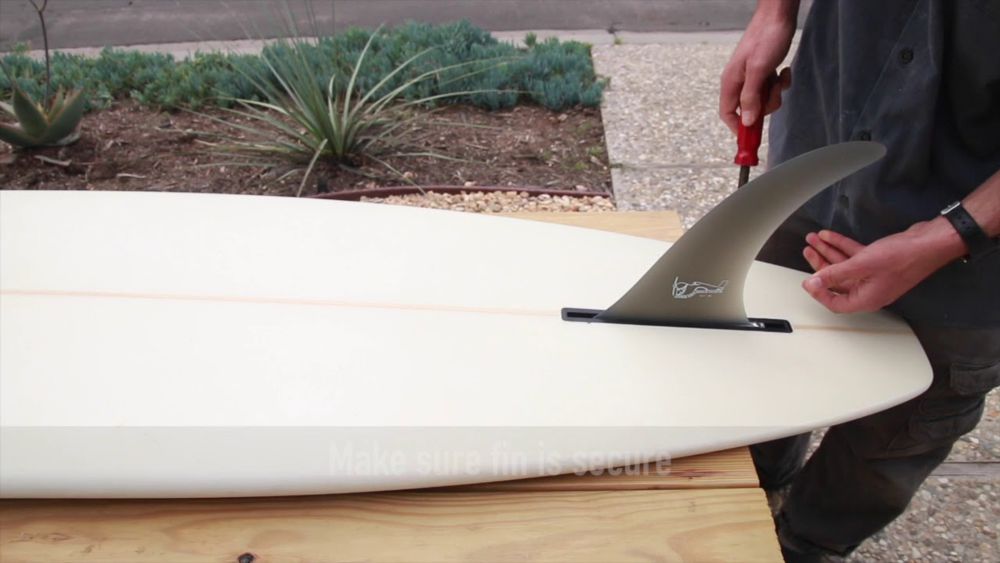
A continuación, se ofrece una visión más detallada de las condiciones ideales de las olas, los pros y los contras de las configuraciones de una sola aleta:
Condiciones ideales:
- Tablas de surf de longitud media y larga: Las aletas simples se encuentran comúnmente en tablas largas y tablas de surf de longitud media, donde su gran área de superficie y perfiles de balancín relajados complementan la naturaleza deslizante de las tablas.
- Crucero y navegación en noseriding: La configuración de una sola aleta se destaca en navegación de crucero y de nariz, permitiendo líneas suaves y prolongadas y maniobras elegantes en la cara de la ola.
- Ondas pequeñas y medianas: Las olas más pequeñas carecen de la potencia necesaria para impulsar configuraciones de múltiples aletas, lo que hace que las aletas simples sean una opción eficiente para atraparlas y surfearlas.
Ventajas:
- Estabilidad: La configuración de una sola aleta proporciona una estabilidad excepcional, lo que hace que sea más fácil equilibrar y controlar la tabla, especialmente para principiantes.
- Planeo: Con menos resistencia que las configuraciones de múltiples aletas, las aletas simples ofrecen un deslizamiento superior y facilidad para remar, lo que permite a los surfistas atrapar olas sin esfuerzo.
- Fluir: La aleta única fomenta giros suaves y prolongados, fomentando una experiencia de surf más conectada y fluida.
- Estética clásica: La configuración de una sola aleta encarna la estética clásica del longboard y evoca una sensación de la rica historia del surf.
- Simple y de bajo mantenimiento: Las configuraciones de una sola aleta son más fáciles de mantener y menos propensas a dañarse con una sola aleta.
Contras:
- Maniobrabilidad: Las aletas simples ofrecen menos maniobrabilidad que las configuraciones de aletas múltiples, lo que hace que los giros bruscos y las maniobras cerradas sean más desafiantes.
- Rendimiento limitado: En olas potentes o huecas, la aleta única puede necesitar ayuda para proporcionar el agarre y el control necesarios para un surf de alto rendimiento.
- Curva de aprendizaje: Dominar la tabla con una sola aleta requiere un enfoque diferente al de las tablas con múltiples aletas, lo que exige más equilibrio y posicionamiento corporal por parte del surfista.
2. Configuraciones de aletas gemelas/dobles
Configuraciones de aletas de tabla de surf Son cruciales para el rendimiento de la tabla en el agua. Como sugiere el nombre, las quillas gemelas utilizan solo dos quillas, generalmente ubicadas simétricamente a cada lado de la tabla. Colocación de las aletas de la tabla de surf Caja cerca de la cola. Esta configuración, popularizada en los años 70 y 80, ha vuelto a ganar popularidad en los últimos años y atrae a surfistas que buscan unas características de rendimiento y sensaciones específicas.
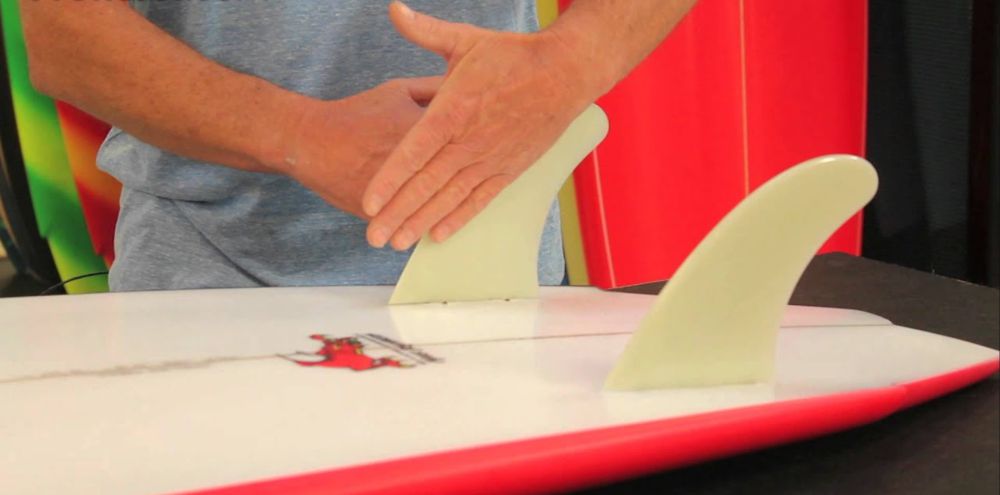
A continuación se muestra una descripción general de las condiciones ideales de las olas, los pros y los contras de esta actividad. Configuración de las aletas de la tabla de surf :
Condiciones ideales de las olas:
- Olas pequeñas y medianas: Las quillas gemelas son excelentes para olas que carecen de potencia y pegada. Su naturaleza suelta y maniobrable permite a los surfistas generar velocidad y fluidez en las secciones de olas más débiles.
- Condiciones limpias o picadas: La configuración de doble aleta puede soportar condiciones tanto agitadas como vidriosas debido a su capacidad de mantener el control y la soltura en varios estados del agua.
Ventajas:
- Mayor maniobrabilidad: Con solo dos aletas, las aletas gemelas brindan una sensación de mayor respuesta que las configuraciones con tres o más aletas. Esto permite realizar giros más rápidos y cerrados, lo que las hace ideales para maniobras suaves y prolongadas.
- Velocidad mejorada: La menor resistencia que supone tener menos aletas hace que la tabla acelere y mantenga la velocidad de forma más eficiente, especialmente en olas más pequeñas.
- Conducción fluida y suave: Las quillas gemelas ofrecen una sensación más parecida a la de un skate que otras configuraciones. Esta sensación más suelta permite un estilo de surf más relajado y divertido, que se centra en el flujo y la generación de velocidad a través de los giros.
Contras:
- Fijación limitada en olas más grandes: Debido a la falta de una aleta central, las aletas gemelas necesitan ayuda para mantener su línea en olas potentes o más empinadas. Esto puede provocar la pérdida de control y dificultad para realizar maniobras cerradas en estas condiciones.
- Menos estabilidad: En comparación con las configuraciones con tres o más aletas, las aletas gemelas ofrecen menos estabilidad general, especialmente a velocidades más altas o al realizar maniobras agresivas.
- No es ideal para principiantes: La sensación más suelta y el control reducido de las aletas gemelas pueden ser un desafío para los surfistas principiantes, lo que las hace más adecuadas para surfistas experimentados que se sienten cómodos con el equilibrio y el control.
3. Configuración de las aletas del propulsor
El Colocación de aletas en la tabla de surf El diseño de las aletas thruster, desarrollado por Simon Anderson en la década de 1980, utiliza tres aletas: dos aletas más pequeñas a cada lado de la cola (aletas laterales) y una aleta única, un poco más grande, en el centro de la tabla (aleta central). Esta disposición ofrece una combinación equilibrada de estabilidad, control y maniobrabilidad, lo que la hace adecuada para varios surfistas y tipos de olas.
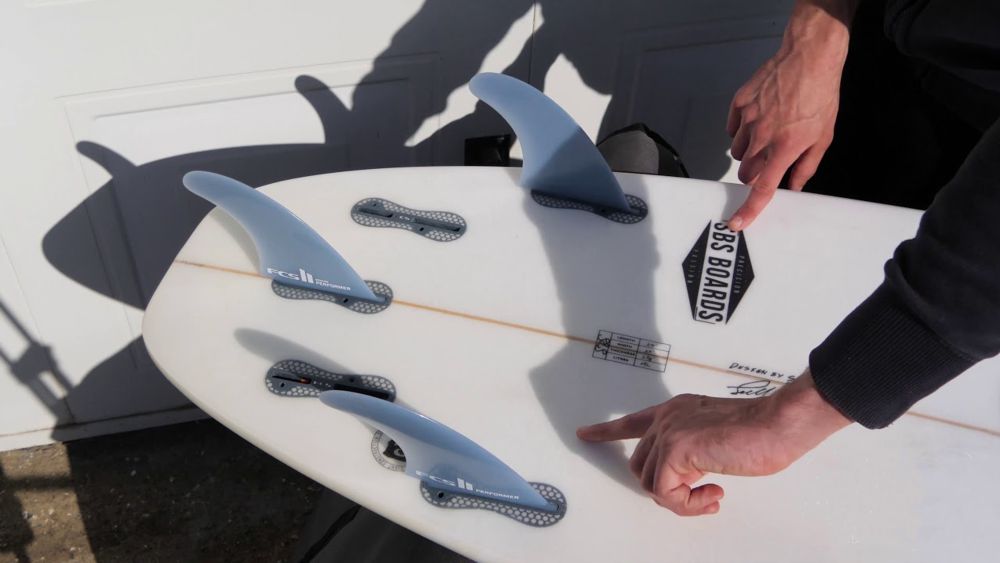
Estas son las características de la configuración de las aletas del propulsor:
Condiciones ideales de las olas:
- Ondas predecibles: Los propulsores se destacan en olas consistentes y predecibles, ofreciendo a los surfistas el control y la estabilidad necesarios para realizar maniobras y mantener líneas.
- Ondas de tamaño mediano: Esta configuración es particularmente efectiva en olas que van desde la altura de la cintura hasta la altura de la cabeza, ofreciendo un equilibrio entre estabilidad y capacidad de respuesta.
- Variedad de tamaños de olas: Si bien el rendimiento óptimo puede variar levemente en olas muy pequeñas o grandes, la configuración del propulsor generalmente se adapta bien a un amplio espectro de tamaños de olas, desde la altura de la cabeza hasta las que superan la altura de la cabeza.
- Diferentes estilos de surf: La naturaleza equilibrada de la configuración del propulsor se adapta a varios estilos de surf, desde realizar maniobras ajustadas y progresivas hasta trazar líneas suaves.
Ventajas:
- Versatilidad: La configuración del propulsor se adapta a una amplia gama de estilos de surf, desde principiantes que aprenden a girar hasta surfistas experimentados que buscan rendimiento en diversas condiciones.
- Balance: La configuración de tres aletas equilibra la estabilidad, el control y la maniobrabilidad, lo que permite a los surfistas superar sus límites con confianza.
- Previsibilidad: Los propulsores ofrecen un rendimiento constante, lo que los hace ideales para los surfistas que valoran el control y la previsibilidad en su navegación.
Contras:
- Menos holgura: A diferencia de las configuraciones de aletas con menos aletas, los propulsores pueden sentirse un poco menos sueltos y maniobrables, particularmente en olas pequeñas y blandas.
- Sintonia FINA: Encontrar la configuración de aletas perfecta para las necesidades individuales puede requerir experimentación, ya que el tamaño, la forma y el material pueden afectar el rendimiento.
- Potencialmente más resistencia: La presencia de tres aletas puede crear más resistencia en comparación con configuraciones con menos aletas, lo que puede afectar la velocidad máxima.
4. Configuración de aletas 2+1
A tabla de surf con aletas es un sistema complejo diseñado para proporcionar estabilidad, control y maniobrabilidad en el agua. Configuración de aletas 2+1 es una opción popular para los surfistas que buscan un equilibrio entre la sensación clásica de una sola quilla y el mayor rendimiento de una configuración thruster (tres quillas). Esta configuración consta de una quilla más grande. aleta única en el centro y dos más pequeños aletas laterales a cada lado, cerca de la cola del tablero.
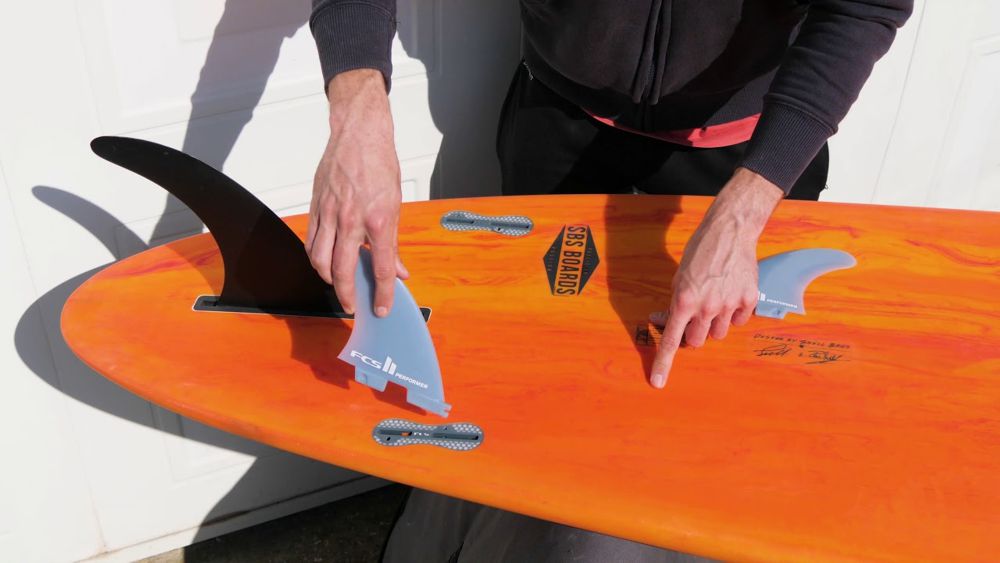
Profundicemos en las condiciones ideales de las olas, las ventajas y desventajas de la configuración de quillas 2+1:
Condiciones ideales de las olas:
- Olas pequeñas y medianas: La aleta central más grande proporciona estabilidad e impulso en olas más débiles, lo que hace que el 2+1 sea adecuado para condiciones menos potentes.
- Crucero y surf en longboard: La configuración 2+1 ofrece un andar suave y fluido, ideal para paseos relajados y estilos de longboard.
- Crucero y navegación con nariz: La sensación de holgura y la estabilidad añadida pueden beneficiar a los surfistas que disfrutan de navegar relajadamente en las olas y realizar maniobras de noseriding.
Ventajas:
- Sensación más suelta: En comparación con los propulsores, la configuración 2+1 ofrece un andar más suelto y con mayor capacidad de respuesta que recuerda a las clásicas tablas de surf de una sola aleta.
- Mayor control: Las aletas laterales añaden control y sujeción, especialmente en secciones críticas de la ola o durante maniobras rápidas.
- Versatilidad: La configuración 2+1 se puede utilizar con o sin aletas laterales, lo que permite a los surfistas ajustar el rendimiento de la tabla para que coincida con las condiciones.
- Generar sustentación: El diseño específico de las aletas puede crear sustentación, ayudando a que la tabla planee sobre el agua y mantenga la velocidad.
Contras:
- Menos impulso en olas más grandes: Es posible que la aleta única necesite más impulso y agarre para atravesar olas más grandes y empinadas en comparación con una configuración con propulsor.
- Menor maniobrabilidad en espacios reducidos: Si bien ofrecen control, las aletas laterales pueden hacer que la tabla se sienta un poco menos maniobrable en zonas estrechas de la ola.
- Requiere experimentación: Encontrar la combinación óptima de tamaño y ubicación de las aletas para la configuración 2+1 puede requerir algo de prueba y error.
- Curva de aprendizaje: Los surfistas acostumbrados a las configuraciones con propulsor pueden necesitar algo de tiempo para adaptarse a la sensación diferente de la configuración 2+1.
5. Configuración de cuatro aletas
Entonces, ¿qué es una configuración de cuatro aletas y sus... Colocación de las quillas en la tabla de surf : la configuración de cuatro quillas en una tabla de surf se ha vuelto cada vez más popular entre los surfistas que buscan características de rendimiento específicas. Ofrece una combinación única de soltura y control, lo que la hace adecuada para condiciones de olas más anchas que las configuraciones tradicionales de thruster (tres quillas).
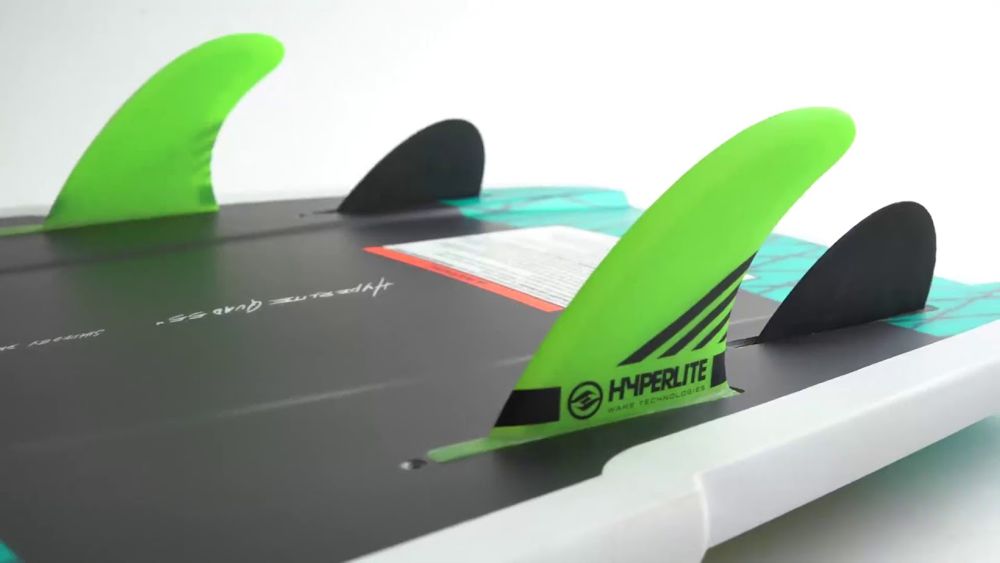
Profundicemos en las condiciones ideales de las olas, los pros y los contras de utilizar una configuración de cuatro aletas:
Condiciones ideales de las olas:
- Olas pequeñas y blandas: Los quads destacan en olas sin potencia, donde las aletas adicionales aportan impulso y sujeción.
- Olas huecas y tubulares: El mayor control de las cuatro aletas permite a los surfistas agarrar las secciones más empinadas de la ola y realizar maniobras potentes.
- Condiciones de viento: Los quads ofrecen más estabilidad y control que las configuraciones de dos aletas, lo que los convierte en una buena opción para olas agitadas.
Ventajas:
- Mayor impulso y retención: En comparación con otras configuraciones de aletas de tablas de surf, las cuatro aletas proporcionan más superficie en el agua, lo que produce una mejor aceleración y agarre, especialmente en olas más débiles.
- Sensación más suelta: En comparación con los propulsores, los quads ofrecen una sensación más suelta, lo que permite giros más rápidos y transiciones de riel a riel más suaves.
- Más control en olas huecas: Las aletas adicionales ofrecen más control y estabilidad en secciones de olas más empinadas, lo que permite a los surfistas realizar maniobras potentes.
- Versatilidad: Los quads se pueden utilizar de forma efectiva en distintas condiciones de olas, desde pequeñas y blandas hasta huecas y tubulares.
Contras:
- Menos holgura que las aletas gemelas: Si bien ofrecen más control que los gemelos, los quads generalmente son menos sueltos y maniobrables, lo que los hace menos ideales para realizar giros cerrados y maniobras radicales.
- Puede sentirse lento en olas grandes: Las aletas adicionales pueden crear resistencia en olas más grandes, haciendo que la tabla se sienta lenta.
- Requiere ajuste: Los surfistas que estén haciendo la transición desde los thrusters pueden necesitar ajustar su estilo de surf para adaptarse a la sensación diferente de una configuración cuádruple.
6. Boost Fin: innovación en quillas para tablas de surf
La tradicional quilla de tabla de surf, un componente crucial para la dirección y la estabilidad, no ha cambiado durante décadas. Sin embargo, la reciente introducción de la aleta eléctrica by Boost Surfing presenta una versión innovadora de este equipo esencial. Esta aleta motorizada integra tecnología de propulsión eléctrica en la tabla de surf, lo que ofrece una experiencia única para surfistas de todos los niveles. Este producto único tiene como objetivo abordar algunos de los desafíos que enfrentan los surfistas y los palistas, en particular cuando reman para atrapar olas o recorrer largas distancias.
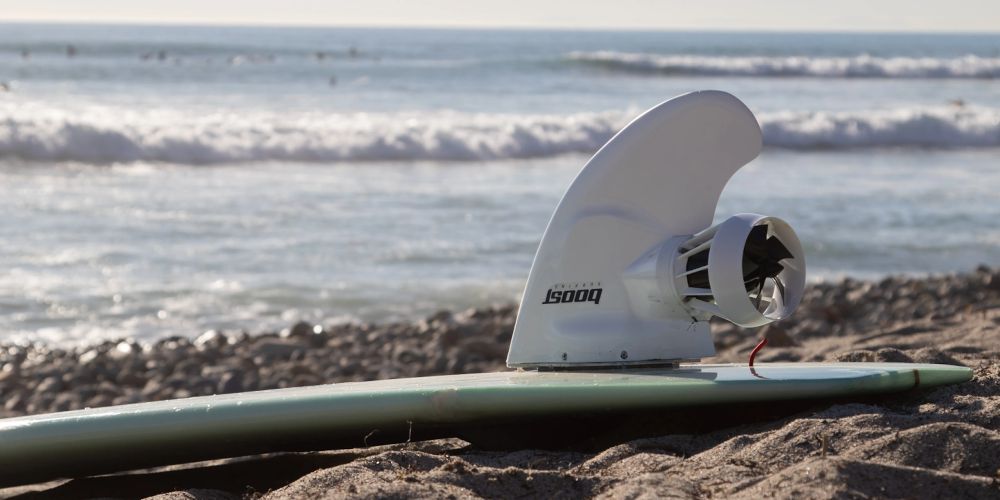
Condiciones ideales de las olas:
- Aguas tranquilas o pequeñas olas: El motor del Boost Fin ayuda a remar, permitiendo a los surfistas llegar a los lugares deseados y atrapar olas que de otro modo podrían perder debido a las malas condiciones.
- Aprendiendo a surfear: Los principiantes pueden utilizar el motor para practicar la técnica y las maniobras mientras conservan energía, lo que hace que la curva de aprendizaje sea menos exigente físicamente.
- Largas distancias: El motor alivia la fatiga de remar durante sesiones prolongadas, lo que permite a los surfistas cubrir mayores distancias y explorar áreas más grandes.
Características:
- Motor eléctrico: Proporciona hasta 20 libras de empuje, impulsando la tabla hacia adelante a velocidades de hasta 5 mph.
- Mando a distancia: Permite a los surfistas ajustar la velocidad y activar el motor para obtener asistencia a pedido.
- Batería de iones de litio: Proporciona hasta 60-90 minutos de uso continuo con una sola carga.
- Construcción duradera: Construido con polímero reforzado con fibra de vidrio y plástico ABS para mayor resistencia en entornos de agua salada.
- Aplicación móvil: Permite a los usuarios personalizar configuraciones, monitorear la duración de la batería y acceder a tutoriales (disponibles en Android e iOS).
- Compatibilidad universal: Se adapta a la mayoría de las cajas de aletas de tablas de surf estándar, lo que permite una fácil instalación.
Beneficios:
- Mayor potencia de remado: La aleta Boost proporciona propulsión adicional, lo que hace que sea más fácil remar hacia las olas o cubrir distancias más largas.
- Fatiga reducida: La aleta ayuda a conservar energía al facilitar la remada, lo que permite a los surfistas y remadores disfrutar de sesiones más largas.
- Accesibilidad mejorada: Las personas con fuerza limitada para remar pueden experimentar la alegría del surf y el SUP con la ayuda de la aleta Boost.
- Conveniente: La aleta se fija fácilmente a la mayoría de las tablas de surf, SUP y kayaks existentes, lo que ofrece una forma rápida y conveniente de agregar asistencia motorizada.
Si bien la aleta Boost introduce un elemento novedoso en la experiencia del surf, es importante recordar que la verdadera esencia del surf reside en la conexión con el agua y el dominio de su poder. Ya seas un surfista experimentado que busca superar sus límites o un principiante que descubre la alegría de surfear olas, la aleta Boost ofrece una herramienta innovadora para mejorar tu tiempo en el agua.
Navegue mejor con las aletas Boost
Comprensión configuraciones de aletas de tabla de surf puede ayudarte a maximizar tu experiencia de navegación. Esto Guía de aletas para tablas de surf ha proporcionado una descripción general completa de las configuraciones de aletas más comunes y sus características únicas. Recuerde, la configuración ideal de aletas depende de su estilo de surf, nivel de habilidad y los tipos de olas que encuentre.
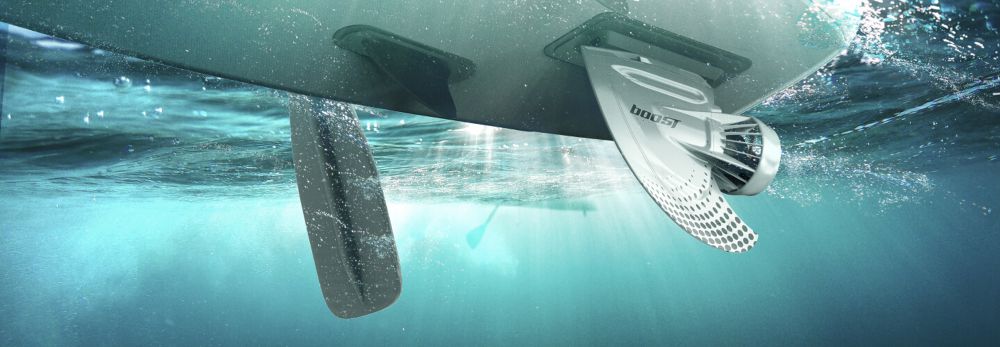
Para los surfistas que buscan un enfoque innovador para mejorar su surf, considere el Aleta de refuerzo de Boost Surfing. Este sistema de aletas eléctricas otorga a los surfistas mayor propulsión y control, lo que aumenta el número de olas, reduce la fatiga y fomenta el disfrute en el agua. Visite el sitio web oficial Impulsar la navegación Tienda online hoy para explorar las posibilidades y desbloquear una nueva dimensión en tu viaje de surf.


Compartir:
¿Cuál es el viento ideal para practicar paddle surf?
Los 5 mejores motores para tabla de remo de 2024